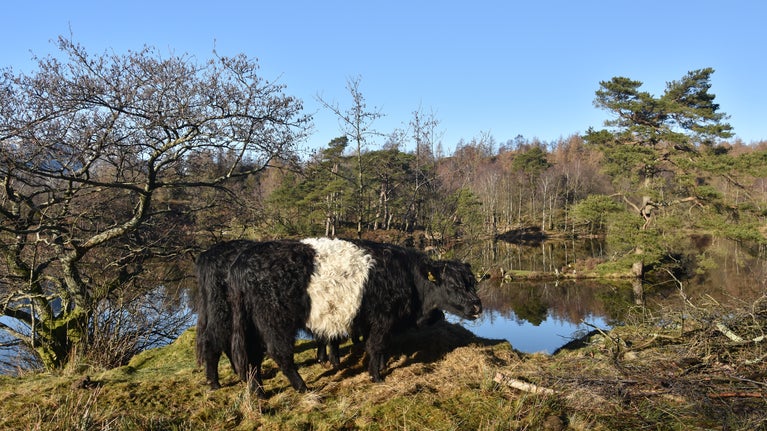
Donate
Everyone needs nature, now more than ever. Donate today and you could help people and nature to thrive at the places we care for.

To look after special places such as Tarn Hows and Coniston, regular conservation work takes place every day so that they are protected for everyone, for ever. Take a look at some of the things we do, from protecting rare habitats to felling trees enhance the conservation of this valuable area.
Windermere’s western shore, Tarn Hows, Silverdale and the Sizergh Estate are just a few of the places where you might encounter a small herd of cattle looking slightly out of place in an area bustling with visitors.
The National Trust, along with other landowners, are working with local farmers to improve wildlife habitats whilst supporting the viability of their farming businesses.
Farming and the Lake District go hand in hand, with the hardy Herdwick sheep synonymous with the region. Sheep, however, graze very differently to cattle. They use their lips and front teeth to select individual plants, targeting only their favourite species – often delicate wildflowers. Over time this can reduce the diversity of pasture as it becomes dominated by the plants sheep prefer not to eat.
Cows differ as they wrap their tongues around clumps of vegetation to pull it up, creating small patches of bare earth ready to be populated by new seeds. They’re also less picky – their gut is capable of digesting tougher plants and their size means they need plenty to keep going.
Weight is also a factor; cows churn up the ground, creating soft, muddy pockets for seeds to germinate. Their size means they break up masses of dead leaves on the ground and create pathways through tall, dense areas. Far from being destructive, their movements provide other species a place to thrive.
Cows are so suited to this role that even their manure has a use; it’s a natural fertiliser which also supports a wide variety of insects including beetles, flies, spiders and earthworms. In turn, birds and bats feed off this new food supply, continuing the cycle. There is no modern way to replicate the efficacy of cattle grazing when it’s done with nature in mind.
On the east shore of Coniston, Park-a-Moor sits high above the lake and is home to a mixture of Luing, Whitebred Shorthorn and Highland cattle breeds. This 40-strong breeding herd have one of the best views in the Lake District, with 150 acres of heathland at their disposal.
The cattle were brought in to break up the dominant purple moor grass and make room for more desirable species such as cotton grasses, mosses and peatland plants which attract birds such as the skylark and meadow pipit. The herd’s introduction into the surrounding woodland has led to a bumper crop of touch-me-not balsam; the only food source for the caterpillar of one of the UK’s rarest moth species, the netted carpet moth.

We recently felled a number of diseased larch trees, to prevent the spread of Phytophthora ramorum, which is a fungus-like virus. It can attack and kill other trees, so it is necessary to take action and we are required by law to fell all larch trees within 100m of each infected tree.
Because of this, parts of the woodland will look quite different for a while. Phytophthora ramorum is not dangerous to humans, dogs or wildlife, but visitors can help to prevent the spread of the disease by staying on marked paths and cleaning mud and needles off boots, (and paws) and pram wheels before they leave.
There is no cure for Phytophthora ramorum and there are no effective chemical treatments available. There are fungicides which can suppress the symptoms, but none which kill the virus.
When phytophthora is confirmed the landowner (in this case, the National Trust) is issued with a Statutory Plant Health Notice (SPHN) by the Forestry Commission. This means that infected, spore producing trees, such as larch, must be felled or otherwise killed as quickly as possible after detection of the disease.

Everyone needs nature, now more than ever. Donate today and you could help people and nature to thrive at the places we care for.

Explore the varied landscape of the Lake District around Tarn Hows and Coniston. With endless walk and cycle routes and a Tramper to borrow, there’s something for everyone.

Discover more about Tarn Hows, James Garth Marshall’s vision to create a designed landscape from three natural tarns and why his vision was never completed.

We believe that nature, beauty and history are for everyone. That’s why we’re supporting wildlife, protecting historic sites and more. Find out about our work.

Read about our strategy, which focuses on restoring nature, ending unequal access and inspiring more people.

Reducing carbon emissions, planting trees and protecting wildlife habitats: just some of the things we’re doing to protect nature and the climate.